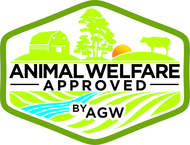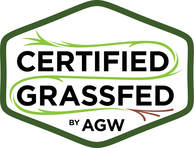|
Last week we went to Central High School in Kenosha County to present to a Freshmen AP Geography class about Sustainable, Organic, and Regenerative Agriculture. It was super fun for Paul and I to talk to kids, who are the future of this country, about what is possible with Regenerative Ag. Something that is catching on in mainstream as a better, healthier way to farm for the environment and for our health.
After introducing ourselves and talking about who we are and what we do, we gave a background about the history of modern/industrial agriculture. Starting with "Old MacDonald", who use to do everything and integrated plants, crops, and a variety of animals, to industrialization bringing machinery, pesticides and fertilizers, specialization and "getting bigger" for efficiency. These were all things that were welcome by overworked farmers and actually did improve the lives and work of farmers at the time. However, nobody was able to foresee the consequences of these. Today, we know what these are- for our health and for the environment. Read about these in slides #16-#17. We then talked about what Organic farming, Animal Welfare, and additional certifications we pursued, given that organic standards have gotten relaxed (especially when it comes to animal welfare) once Big Ag got into it. Lastly, we talked about Regenerative Agriculture as a system of principles and practices that is not only "sustainable" but actually increases biodiversity, enriches soils, improves watersheds, and enhances ecosystem services. We talked about the importance of SOIL health. It ALL starts with healthy soil, something I found interesting and contrasting coming from a nutrition world when Hippocrates said "all disease begins in the gut". in human health, we have discovered most disease starts with an unhealthy gut. Similarly, we are now realizing, a healthy environment, and healthy food, starts with healthy soil. We explained the differences of grass fed vs. grain fed cows for beef and dairy. There are numerous health benefits of grass fed beef vs. grain fed, which includes less saturated and overall fat and more of the good fats like Omega 3s and CLA's in grass fed beef and dairy. We touched on the economics of farming, a sad reality of our broken food system that pays more for cheap, processed, and industrialized food than it does for "real food". It is more profitable for many farmers to grow commodity crops like soy and corn, sell them to the market where they get processed into your packaged food, and sold for very cheap at the store- than it is to grow healthier vegetables or pastured animals. Lastly, we provided a number of resources of local and some national organizations that have a wealth of information on these topics, and also some interesting books and documentaries we thought the kids (or anybody!) might like. At the end, we took in questions... with many very thoughtful and interesting questions coming from the kids. We welcome questions from you too! Please leave a comment, emil us, or contact us if you have any questions about anything you read in the presentation, what we do, or anything you'd like to ask us! We are happy to answer as best we can! Thanks for reading, and stay tuned for some more "educational" posts coming in the next few months.
0 Comments
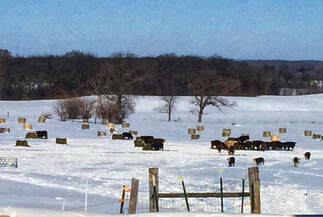 As the year approaches its final, festive days, we look back at 2019 before we look forward, and there is much to celebrate and be grateful for. Here are some snippets of our 2019 and things we look forward in 2020! Polar Vortex We started the year with a Polar Vortex that tested all our “winter systems” at the farm. Paul nervously went to check cows every morning and afternoon during the vortex to make sure water was running and cows were taking shelter. To his surprise, while many cows where in the barnyard cozying up together, some decided they’d rather be outside in subzero temps- crazy girls! but they all made it through without a hitch! 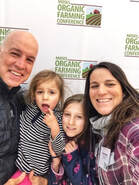 Farming Conferences During late winter, we attended two very educational and fun Farming conferences- Paul did Grass Works Grazing Conference in the Dells (the gils and I joined for the water park fun) and we all went to the MOSES Organic Farming Conference in LaCrosse. This was the first year we bring the girls and they really enjoyed it, made new friends, and learned a bit more about what we do as well as meet some of our peers and mentors.  Spring Calving Season Calving season started rough with the loss of a couple of calves that didn't make it. It happens, it's nature, but it is always hard and sad to experience. After that, it quickly picked up with about 20 healthy calves born between late April to mid- June. Summer- Farmer’s Markets This was our first year doing farmer’s markets. We were at the Kenosha Harbor Market and Boxed and Burlap in Delavan, and both were very successful and fun! We admit while it is a lot of work, we really enjoy meeting new people, talking about what we do, and seeing so many of our customers come out and support us. We continue the Kenosha Winter Market once a month indoor at the Kenosha Masonic Center and will be back outside in the summer by the harbor. Family Vacations For Spring break we had a lovely family trip down south to New Orleans. What great memories we made! Full of music, art, good food, alligators, lots of beads and southern charm! In the summer, my parents were visiting from California and we all enjoyed a few days exploring beautiful Door County- watching sunsets, walking around the lovely small towns, shopping, and enjoying some beautiful (and a tad bit cold) beach days!  Farmhouse Construction Our farmhouse construction got VERY delayed due to a rough winter and other hiccups, but while it has been slower, we have been able to enjoy and learn every step of the process. Perhaps this is what has made it less stressful, but we must admit what we feared would be an awfully stressful experience has been a very fun one. We think a big part of the credit goes to the amazing team we have been lucky to work with- from the architect, to the builder, to the Passive house inspector and everyone involved. Stay tuned as we share our progress and finally (hopefully!) a Spring move to the farm! Growing our Market It has been super exciting to grow our customer base and this year has been a very successful one in that! Now that we’ve been in business for 4 years, we have some loyal, supportive customers that buy their bulk annually or stock up on their beef every couple of months. Our customers are in a variety of places from Chicago all the way to Milwaukee suburbs, but it has especially been neat to see our local community of Kenosha and suburbs supporting us! Things we are planning and look forward for 2020:
We are grateful, excited, and hope to see you in 2020! Wishing you and your families Happy Holidays and a Happy and Healthy New Year 2020!! 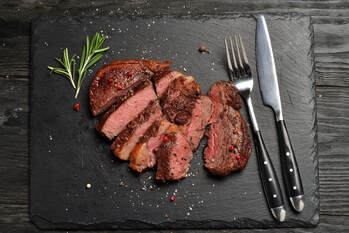 Farming for grass fed beef takes a lot of work, care, and love, and so when we sell our beef we are proud of our product. We also realize this is in investment you are making in quality beef that is healthy, nutritious, and delicious for you! Many times we see/hear customers grilling their steaks too long, cooking them well done (eek!), or making typical cooking mistakes and it just breaks my heart... so we want to give you some tips on cooking your grass fed steaks properly. I won’t reinvent the wheel, because much of what I’ve learned about cooking grass fed beef I owe it to Shannon Hayes and the Radical Homemaker’s cookbooks, so I will just quote below one of her very well written and truthful blog posts on mistakes done when cooking grass fed steaks. Here goes… 5 Typical Mistakes When Cooking Grass Fed Steaks 1. Wet steak. Thawed steak is going to be moist. In order to sear it properly, it must be dry before you put it on the grill or in the frying pan. If the steak is not blotted dry with a towel before you apply salt and pepper, it will not sear, it will steam. 2. Wrong pan size. If you are cooking your steaks indoors, be sure to choose a skillet that allows ample room to sear them. When the steaks are too crowded, even if they have been blotted dry, the excess moisture will cause them to steam rather than brown, leaving them with an unpleasant gray pallor. Make sure your steaks have at least 1 inch of space around them in the skillet to prevent this from happening. 3. Wrong direct-heat temperature. Often in our hunger for a great steak, we fail to wait for our grills and skillets to heat up properly. If the grill or skillet is not hot enough, the meat will start to roast, but it will not achieve that glorious sear that adds flavor. If grilling, hold your hand about 4 inches above the grate. When you can hold it there for no more than 4 seconds, the grill is hot enough for you to sear your meat. When cooking indoors, place the skillet over a hot flame. When you see steam rising off the skillet, you are ready to grease it with a little fat and begin searing. 4. Failure to allow for indirect cooking time. High heat is critical only when we begin cooking steaks to achieve the sear. A steak should be exposed to high direct heat for no more than 2 minutes per side. After that, in order to guarantee tender and juicy meat, it should be removed from the flames and allowed to finish in indirect or low heat. If you are cooking the steak on the grill, simply move it off the flames and put it on the side of the grill that is not lit, set the cover in place, and allow it to cook for about 5-7 minutes per pound. If you are cooking it indoors, once the steak has seared, transfer the skillet to a 300 degree oven for about 5-7 minutes per pound (or to a 200 degree oven for about 10 minutes per pound). During that indirect time, the internal muscle fibers will come up to temperature slowly without contracting too tightly and toughening. Also, the proteins and sugars will have time to caramelize over the surface of the meat, giving the steak that characteristic glossy look and rich taste. 5. Wrong doneness temperature. USDA temperature guidelines suggest that beef should be cooked to a minimum temperature of 145 degrees. Yuck. When you are using reliably-sourced grassfed meat, you don’t run the same risks of consuming food borne pathogens. Thus, cook the steak to an internal temperature of 120 degrees for rare, 140 degrees for well-done (or better yet, don’t cook it well done… ever!) 6. Marinating the wrong meat. Did I say there were only 5 commonly-made mistakes? Oops. I just thought of another one. So there are actually six. At my market booth, folks have a tendency to purchase the rib eyes, top loins, porterhouse, t-bones and sirloin steaks when they are planning a steak dinner. Those are perfect if you are planning to season them only with a little salt and pepper. However, if you are planning to marinate your meat, these are the wrong steaks to bring home. These tender cuts of meat have the most delicate flavors, and their beefiness is easily upstaged by most marinades. Furthermore, if marinated too long, the acid in marinades pre-cooks the meat, turning it gray and leaving an otherwise tender steak mushy. If you have a marinade you plan to use, select the lower-priced cuts, such as the sirloin tip or London broil (top round steak). Those cuts have enough extra flavor and connective tissue to stand up to the marinade. Their more pronounced beefy flavor won’t be overpowered by the stronger seasonings, and the acid in the marinade will help break down some of the connective tissue. So there you go… enjoy your grilling season and grass fed steaks! And for cooking advice of other cuts, check out an earlier blog post I wrote on Cooking Grass Fed Beef. Last month we talked about Nose to Tail eating, what it means, and why it is so important for sustainability, the environment, respecting the animals, and even your health! Read that blog post if you haven't and then come back..
Today (and appropriately during Earth Day week) I will tell you "how to" buy, cook, and eat nose to tail the way that is appropriate for YOU and your family. Nose To Tail "How To":
And as farmers and stewards of our land and animals, we THANK YOU for helping us in our mission to a more sustainable food system and planet! 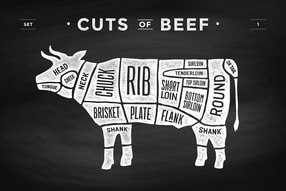 Sustainability These days I hear “Nose to Tail cooking” as a culinary trend and I’m happy about that! Nose-to-tail cooking is all about sustainability, and this is very important to us- and it should be for you too! See, a farmer can’t raise a pork chop. A farmer can’t raise a rib eye steak, or a leg of lamb. You have to raise a whole pig, a whole lamb, and a whole cow. It’s pretty simple: Tossing out valuable parts of the animal doesn’t make sense environmentally or economically. But what does “nose to tail” mean? It means eating and using all parts of the animal- its less popular steaks, roasts, organ meats, bones, even the tallow has (once again) become a popular fat to use for cooking. This is why by selling in bulk, we encourage sustainability, and a more economical way for our customers to get quality grass fed beef. Nose to Tail Around the World Using the whole animal is a practice that is still common in many countries around the world. We experience this firsthand in travels to Uruguay and Argentina- where they are so proud of their (grass fed) beef and will gladly talk to you for hours about where it comes from, the different cuts, how to cook it, and how to eat it. In Barcelona, we went to the famous market “La Boqueria” where they sell everything under the sun, including EVERY cut imaginable of meat. I admit seeing the lamb’s head for sale blew me away! However, aside from this ultra-foodie “nose- to tail eating” trend, it has largely slipped from the Western mindset. I think this is mainly due to the lack of connection we have from our food sources, embodied by the fact that meat has become industrialized and is now perfectly portioned into pink patties, shrink-wrapped in plastic and resembling in no way whatsoever any known animal. Unfortunately for us, in our finicky attitudes about food, we’ve been overlooking fine cuts of meat, tasty delicacies and, of course, the spice of life — variety! Honoring the Animal and Our Environment To maximize the nourishment you can receive from a living creature is to honor that it was, in fact, living. By not using the whole animal, we’re not respecting other living creatures. Giving thanks to the animal for supplying your meal is a good start, but it’s really when we choose to honor the whole animal that we take a step forward in mindful consumerism and changing our food supply system. In so doing, we encourage a mindset that fights excess waste and increases appreciation for the animals that nourish us. For Your Health A direct effect of eating the whole animal is- it’s good for your body. As I learned in my nutrition studies, Americans tend to promote certain cuts more than others (i.e. chicken breast, salmon, tenderloins, etc..) but the reality is, just like humans, animals store different nutrients in different parts of their bodies, and by eating the same cuts over and over, you are getting the same nutrients and neglecting to get other important ones. Our Own Experience A few years before starting our farm, we bought our first ¼ beef steer from our farming mentor, and now friend, Krusen Grass Farm in Wisconsin for our own beef consumption. I won’t lie, when Paul told me about trying it out, I hesitated. At that point, I knew nothing about “bulk buying”, how it works, how much beef I was going to get, and exactly what cuts. I was used to cooking with ground beef and the occasional steak Paul would throw on the grill, but beyond that, I knew nothing about a pot roast, a round steak, and slow cooking beef was a concept beyond my culinary repertoire. The experience of buying in bulk opened a new world of cooking and flavors for us! We had to do something with the cuts of beef I knew nothing about- so I’d look for a recipe, cook it up (way easier than I ever thought) and be surprised by how delicious and easy it was to cook all these different cuts!. We were very pleased by chuck steaks, and top butt steaks, rump roast, sirloin tip, round steaks, and even tried a couple of liver pate recipes that actually delighted us! This idea that by buying a ¼ of an animal, splitting the entire animal with others, gave us a good feeling that we were honoring the whole animal as well as helping the farmer go through its inventory. We encourage our customers to buy in bulk, but otherwise to try different cuts of beef. We are here to help with cooking instructions and/or recipe ideas! And stay tuned for next month when I will blog about “Nose to Tail How-To”. I've been really inspired lately by cooking the more unusual cuts of beef. I want variety from ground beef and honestly, the more popular steaks can be expensive for a regular weeknight family meal. Round steaks is one of those cuts that people think as being tough and lean and so we shy away from it, but let me tell you, this recipe won in our house and I am SO excited to show you a new, super easy, super inexpensive way to eat a "steak" on a weeknight without breaking the bank! Ingredients:
Directions: Add the tamari, ginger, sesame oil, honey, shallot, garlic, mirin, and crushed red pepper to the small bowl of a food processor. Puree. Place the marinade in a glass bowl and add the beef. Turn to coat. Marinate for at least 1-2 hours or overnight (covered) in the refrigerator. When you are ready to cook the steaks, remove them from the marinade and blot dry. Heat a skillet over medium heat. Add just enough oil to lubricate the pan, then add the steaks, laying them flat. Take care to cook only a few at a time so that there is ample space around each piece of meat, otherwise it will not brown. Fry 30 seconds per side, or until browned. Repeat with remaining steaks, using additional fat if needed. Serve immediately. We like these served with brown rice and a side of sauteed veggies! Serves 6. 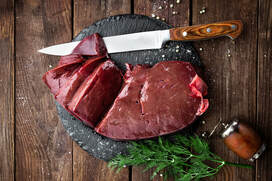 In the spirit of “new year, new you health resolutions”, I figured I’d talk about one of the healthiest products we have at our farm. Beef liver. Now hold on, don’t go… I know many of us didn’t grow up eating liver, and maybe you are disgusted by it (I was!), but I beg you to please stay with me and at least read the rest of this post. Health Benefits: While studying nutrition, I heard so much about the health benefits of beef liver- it was even sometimes called a “super food”! Interestingly, it was once a popular and treasured food source, but liver has fallen out of favor. This is unfortunate because liver is possibly one of the most nutrient-dense foods on the planet, and inexpensive too! It is rich in protein, low in calories, and packed with essential vitamins and minerals. People often look to fruits and vegetables for vitamins and minerals, but liver far surpasses them all in terms of nutrient content. A small amount of liver provides well over 100% of the RDI for many essential nutrients. Here are some nutrients found in a 3.5-ounce serving of beef liver:
How to Include Liver in Your Diet: I admit it, liver has a unique taste, which some people love, and others hate. I know it was tough for us to stomach it the first time we tried it, so I’ll give you that, BUT… here are some suggestions on how to include it in your diet and get these great nutrients:
Recipes to Try: While our recommended way to start eating liver is the "mince, freeze, and add to ground beef" method, here are a couple of good recipes if you want to try. This might be the best Liver and Onions Recipe we've found: http://ediblearia.com/2009/07/23/not-your-average-liver-and-onions/ Beef Liver Pate: https://autoimmunewellness.com/bacon-beef-liver-pate-with-rosemary-and-thyme/ P.S. Beef Heart has a much, much milder flavor than liver and has some of the same nutrients. It’s a lot like ground beef, but I would classify it as “sweeter.” Whereas you’d only add 1-2 cubes of liver to any dish, it’s pretty easy to add up to a quarter pound of heart to a pound of ground beef, even in grilled hamburgers! ***Both Beef Liver and Beef heart are FOR SALE on our web store- so give it a try and REALLY get healthy this new year!***  We have a cookbook with this name and I always LOVED the title, cover picture, and what it is about- comfort food for the long, cold nights of fall and winter, to share with friends and family. The book is now somewhere in our storage unit, and I miss it, but I'll have to wait until next summer to see it again. Lately I've been craving these comforting, slow cooked, warming foods. Despite what many think - that beef is a thing of summer grillin'- our bodies actually crave meat in the wintertime more than any other time of the year. It makes sense. We are trying to warm ourselves and need more fat and protein to do so. The body knows what it needs. When it comes to our beef, there are a few favorite winter dishes we wanted to share with you: Osso Bucco Beef Shanks A classic of my mom. She makes Osso Bucco on special occasions but usually with the more traditional veal shanks. However, she was SO happy to get her hands on Starry Nights beef shanks- it turned out perfect! We think the beef shanks adds more flavor than the veal shanks do. Download this recipe, try it with Starry Nights Farm beef shanks, and enjoy! Get beef shanks ON SALE NOW here. Slow Cooked Beef Short Ribs Just made a batch last week (and posted step-by-step instructions on our Instagram story- follow us so you don't miss next time!) and they turned out terrific- just perfect for that first snow last week! This recipe is delicious, easy, and using our homemade beef bone broth, made it extra great! Download recipe. Get short ribs ON SALE NOW here. Grass Fed Beef Chili Who doesn't like a Chili bowl on a football Sunday? Cheer for the Packers (sorry Bears fans!) while enjoying the best chili with our premium, dry aged, grass fed ground beef. Download recipe here. Get ground beef here. P.S. Stock up on these items ON SALE NOW to make your favorite wintertime beef dish! 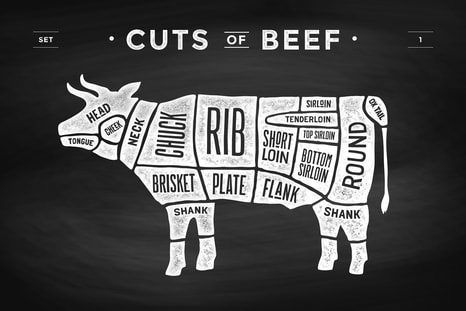 When practicing health coaching, one of the biggest complaints I (Marisa) would get from clients I'd recommend eating grass fed beef, pastured meats, and organic fruits and vegetables, was cost. I get it, conventional beef (most likely raised in a CAFO) is cheaper, but we've already talked about why that is and the environmental and health implications of that in this blog post. We've also talked about the very well documented and researched health benefits of grass fed beef vs. conventional, grain finished beef in this blog post. So by now you are convinced you want to, but don't know how you can afford to eat organic, grass fed beef. Today I'd like to give you valuable advice on how to eat grass fed beef without breaking the bank! Eat Less and Smaller. We need to start by talking about how much and how often we should be eating beef so our expectations are clear. I personally recommend you eat beef no more than 1 or 2 times per week. I know, and I'm a beef farmer! BUT... when you do, make it great quality- organic, grass fed and grass finished. The rest of your week you can vary between other meats, fish, and legumes for your protein. As far as the portion size, the giant 1lb+ steaks you see at some restaurants are completely unnecessary, and unhealthy! A 6oz portion (maybe 8oz for men) is more adequate, the rest of the plate should be filled with greens, vegetables, and whole grains. Try Variety. We all know the (premium) Ribeye, T-bone, and NY strip steaks, the tenderloin, and ground beef, but aside from that, very few tend to eat the rest of the animal. I believe marketing and fad diets in our country has made us too limited in the way we eat. "Tenderloin is lean and tender”, “chicken breast is healthier than dark meat”, “salmon has the most omega-3s”, etc.... Mass production of meat then goes into supplying these demands and we keep eating the same stuff, over and over, and of course, demand drives supply- and price. Variety is also important in our diet, not only so you don't get bored, but also because different parts of the animal contain different nutrients- so this way of eating is not only natural (we should be eating the entire animal!), but healthier. Try some of the more economical cuts, that when cooked properly (slow cooked, marinated, tenderized, etc) taste delicious! and are as nutritious and many leaner than your usual cuts. Premium Cuts are an Occasional Treat. Of course... we all love a super tender filet mignon, Porterhouse steak or fattier Rib eye steak, but these more expensive cuts should be treated as an occasional treat and not a weekly family BBQ feast, or you WILL break the bank! A funny story... last week a friend and loyal customer texted me saying "Wow, that Porterhouse was amazing" and Paul commented "I wouldn't know" because we rarely ever have steaks! (yes, "the shoemaker's children always go barefoot"). Last week was his birthday, so I decided to "treat him" with some of our very own steaks for dinner- we made a nice little feast of Porterhouse, flank, and sirloin steak and oh... did we enjoy it all! The point is, on our weekly meals I incorporate other leaner, cuts of beef and of course, the super versatile ground beef, and on special occasions, we go for the premium steaks! Buy in Bulk. For a few years before starting our own farm, we used to buy ¼ steer annually from our farm mentor, Krusen Grass Farm for our own beef consumption. This was such a wonderful experience, and also very educational. Getting all kinds of different cuts opened our eyes to new flavors and new ways of cooking and we always had beef in our small garage chest freezer for our weekly meals! Some of you already buy in bulk, and others have heard of people that buy a quarter beef cow or a half. Some think that sounds like too much, but a quarter is actually not that much and keep in mind it lasts up to a year and is THE most discounted way to buy your beef! This is a great way of stocking up on quality, affordable, grass fed beef that will last you a long time. Click here to learn more about buying in bulk from Starry Nights Farm. Next ones will be ready in December Sign Up for SALES. If you haven't done so already, sign up for our newsletter and stay updated on our news. We often have SALES on products and it is a great opportunity to stock up on grass fed beef for a budget! Hope these tips help, and thank you for supporting of our business! 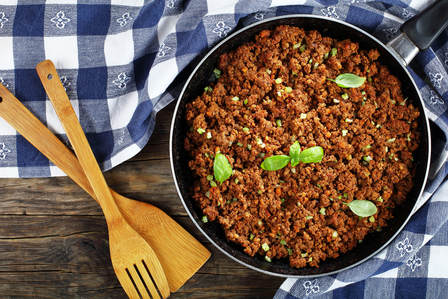 One of the best things about being a farmer has been having our very own stash of quality, organic, grass fed beef available at all times, but I must say, the easiest and most versatile to use is our ground beef. But, what's special about our ground beef? It is Premium You might think all grass-fed ground beef is equal, but in addition to being certified organic, ours is dry aged for at least a week and it comes from the whole cow. So all those delicious cuts of the rib and sirloin are ground up with the rest, giving our ground beef exceptional taste and even more health benefits including vitamins, minerals, and nutrients found in the WHOLE animal, and not just the scraps in typical ground beef. It is Local Yes, you might find grass fed ground beef these days in your nearest big box store, but keep in mind that while it might say it comes from the US, it probably doesn't. How? Read more on this blog post we wrote about the reversal of the "Country of Origin Labeling Law". Most likely your beef comes from far away places like Australia, New Zealand or South America, traveling halfway around the world to get to you. Ours will only travel from our Wisconsin family farm to your table. It's Versatile In addition to being one of the most affordable beef products, the best part of ground beef is its versatility. I admit, before becoming a farmer, we rarely bought ground beef. For burgers occasionally or a specific recipe, but I just didn't think of it in my family meal rotations. However, having them handy in the freezer has been salvation for a quick family meal! Easy to defrost and with endless possibilities to use, it makes dinner planning and prepping super easy! Here are 30 ways to USE GROUND BEEF (some with links to recipes!) to give you many ideas on how to use your Starry Nights Farm grass fed, ground beef:
and saving the best for last... 30. Wisconsin Butter Burger : ) Shop for your GROUND BEEF here and enjoy! |
AuthorMarisa usually writes about nutrition, grass fed beef, organic agriculture, as well as sharing delicious recipes; Paul writes about farm work- sharing his stories and experiences, and most times... we both collaborate on the stories! Archives
March 2024
Categories
All
|
 RSS Feed
RSS Feed

